Comparing dig vs. no dig soil in a market garden
Charles Dowding has been growing organic, no dig vegetables since 1982. He has become a leading source of inspiration and knowledge for gardeners around the world who want to take better care of their soil by allowing nature to do its work undisturbed. Read more about his story and techniques on his website.
Last summer, I contacted Charles to ask if he would send me some of his garden soil to look at. He sent one sample from the garden in general, and a set of two from his trial beds comparing dig vs. no dig management. He does a video walkthrough of the trial beds here, and the trial is described in detail on his website here. He started this trial back in 2013, and has kept diligent records of the inputs, soil management techniques, yields, and plant conditions, so it was the perfect opportunity for a side by side comparison of disturbed and undisturbed soil.
Microscope analysis results
I processed the samples using my usual microscope analysis method. Overall, the no dig bed had noticeably better physical condition and was more biologically rich compared to the dug bed. You can see the full reports here and here, or continue reading for a summary of the findings.
Bacteria
The general garden sample was estimated to have an equal balance of bacterial and fungal biomass, which is generally considered ideal for most crops. The trial samples were both mildly bacteria dominant and had greater numbers of visible bacteria (and fewer fungi) compared to the full garden. Bacteria in the no dig bed appeared to be slightly more active, with some evidence pointing to increased bacterial diversity.
Fungi
Estimated fungal biomass was low in both of the trial samples, but considerably higher in the full garden. Charles suggested that low fungi in the trial beds could be related to the plots having raised walls, whereas the rest of the garden beds have contact with the wood chip paths. He said he would consider spreading some composted wood chips on the trail beds to see if that will make a difference.
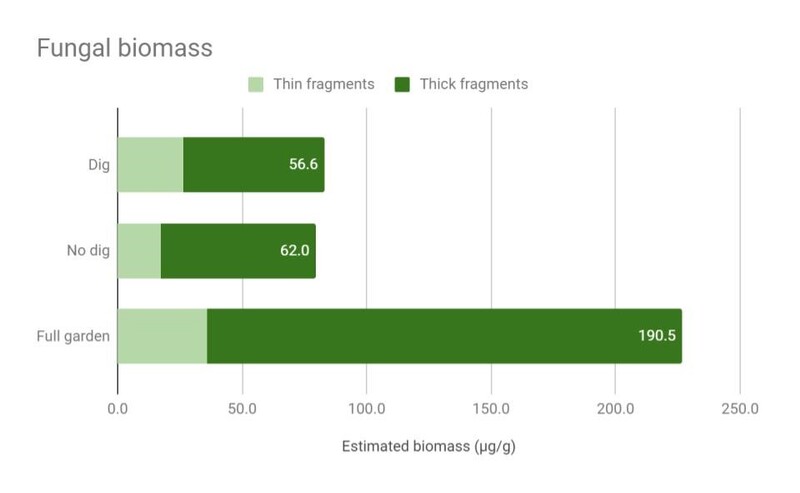
The estimated fungal biomass in the trial beds was similar with a very small increase in the dug bed, but the fungal hyphae in the no dig beds were more robust, as indicated by the proportions of thin vs thick fragments in the chart above (Figure 1). This makes sense, since fungal networks are easily damaged by physical disturbance in the soil, and they are slow to recover.
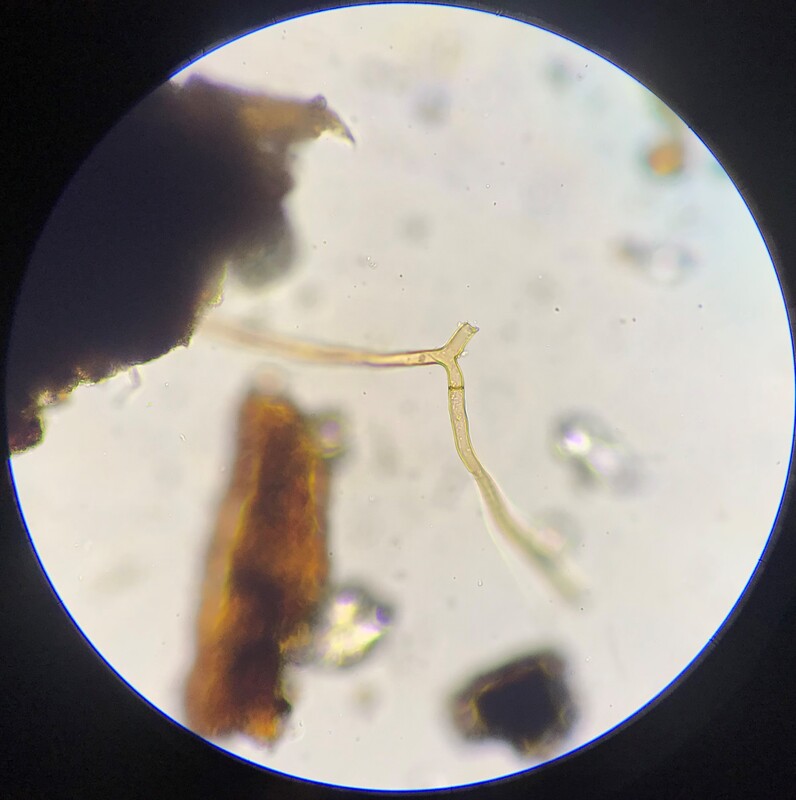
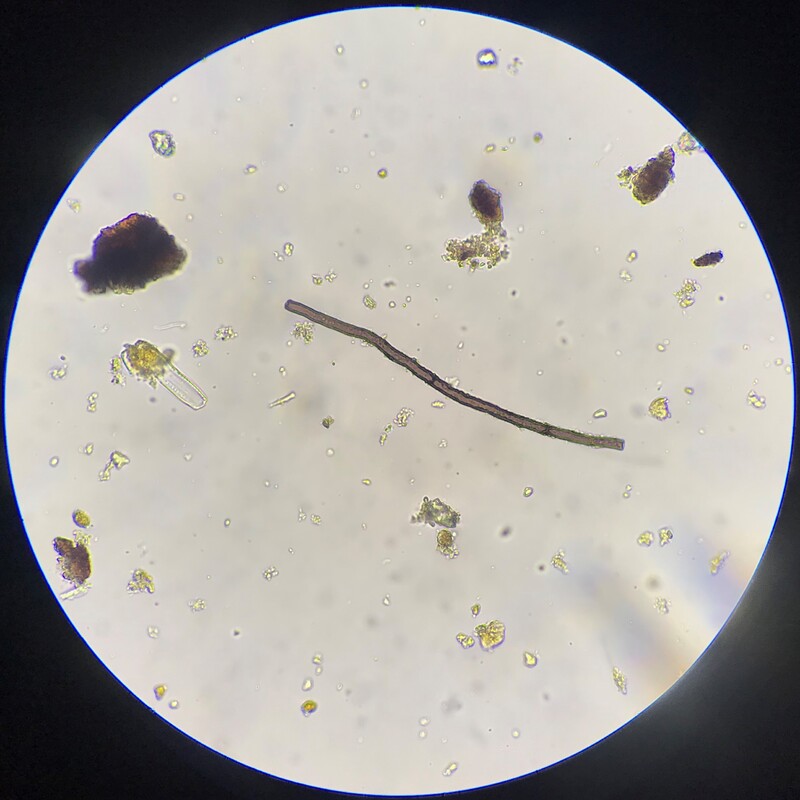
Protozoa
Protozoa are important but often underappreciated members of the soil food web. The main ecological role of soil protozoa as it is currently understood from our perspective is to free up nutrients that have been immobilized by bacteria, completing what is known as the “microbial loop”. Different species of protozoa are known to selectively hunt particular types of bacteria, so if there are many types of protozoa, it could be a sign that there are many types of bacteria as well. Protozoa have also been found to provide benefits to plants that extend beyond the release of nutrients, such as improved growth and disease resistance.
In these samples, there was a considerable improvement in protozoa abundance and diversity in both the no dig trial bed and the full garden sample, compared to the dug bed (Figure 3).
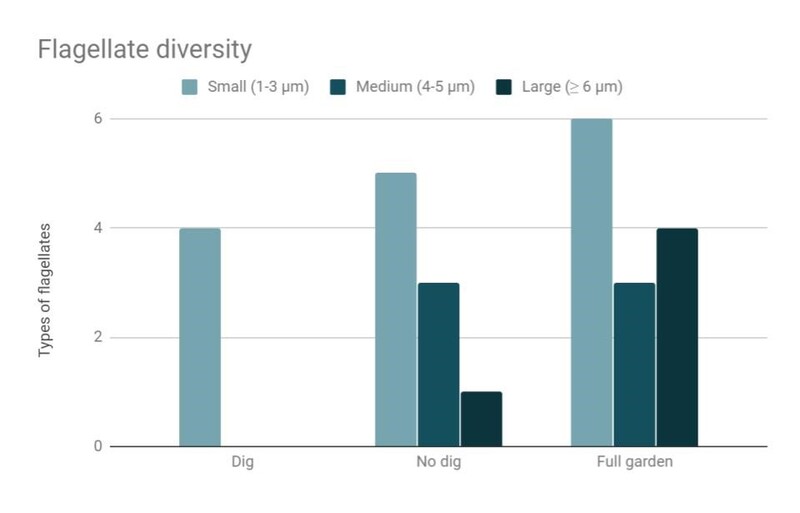
The chart above displays the different types of flagellates divided into groups according to their approximate size. Larger flagellates require good habitat and resources to support them, and a flagellate-friendly habitat is also good for plant life. There were healthy proportions of small, medium, and large organisms in both the no dig trial bed and the full garden, whereas the dug bed had only small flagellates.
Single celled eukaryotes |
Dig |
No dig |
Full garden |
|---|---|---|---|
Testate amoebas |
12 |
216 |
48 |
Round testate amoebas |
0 |
24 |
0 |
Flagellates |
144 |
444 |
1104 |
Ciliates |
0 |
24 |
24 |
Cysts |
144 |
288 |
240 |
Diatoms |
156 |
252 |
228 |
Naked amoebas |
12 |
84 |
72 |
Heliozoa |
0 |
12 |
0 |
Types of flagellates |
4 |
9 |
12 |
Number of groups |
6 |
9 |
7 |
Biodiversity Rating |
1.5 |
1.8 |
1.3 |
Total evaluation of protozoa |
1.8 |
2.2 |
1.8 |
The “biodiversity rating” takes into account population sizes as well as how those populations are distributed among the different groups. If a sample has a very large population of one type of organism and only a few others, it will receive a lower score, but if it has low populations of many groups it will receive a higher score. The full garden sample received a lower biodiversity rating than the other two because the number of flagellates was so much higher than that of other organisms. However, that sample also had the greatest diversity within the flagellate groups (which is not included in that score - it’s a work in progress), the best balance of bacteria and fungi, and the greatest fungal biomass by quite a lot. This is a good demonstration of how challenging it is to try and evaluate such a complex system using simple scores, and how important it is to consider the full picture.
The no dig samples had considerably higher populations of single celled eukaryotes across the board as well as a greater variety of these organisms compared to the dug bed. This suggests that the soil from the no dig beds offer a more complex habitat which is able to support greater abundance and diversity of single-celled organisms.
Physical condition
The difference in the physical condition of the trial samples could be seen even before looking into the microscope. When the samples were mixed with water, the water in the no dig sample was much clearer; a sign of better structure. Good aggregation binds soil particles in place and protects it from erosion by wind or rain, among many other benefits. Microbial slimes and glues bind soil particles into tiny clusters called microaggregates, which form together into larger aggregates which hold the soil in place. Better aggregation also allows soil to lock up more carbon from the atmosphere and provides better physical habitat to support more complex, diverse microorganisms, and a supportive environment that plants can thrive in. Microaggregates appear in the microscope as large, solid masses. It is a good sign if a sample has many of these clumps with a smaller amount of loose debris in the open spaces between them.
There was a very noticeable difference in the physical condition between the dig and no dig samples. All samples did appear to be rich in organic matter, but the no dig samples were exceptionally clean and well aggregated. The structure was significantly weaker in the dug soil, with more loose, unbound debris and fewer large aggregates (Figures 4-5). The no dig samples had a very clean appearance with large, strong aggregates and very little unbound material (Figures 6-7).
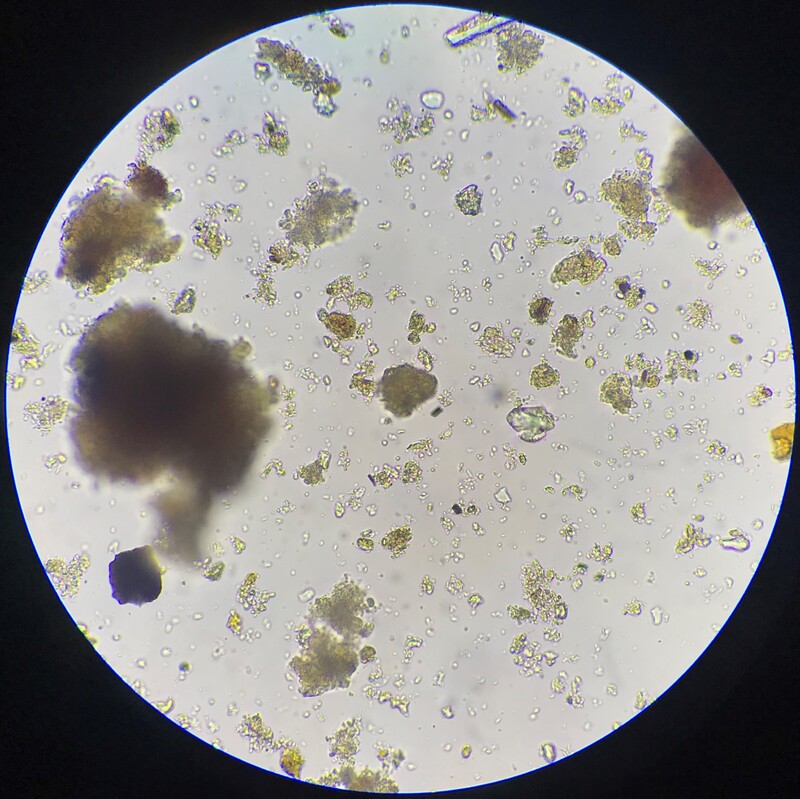
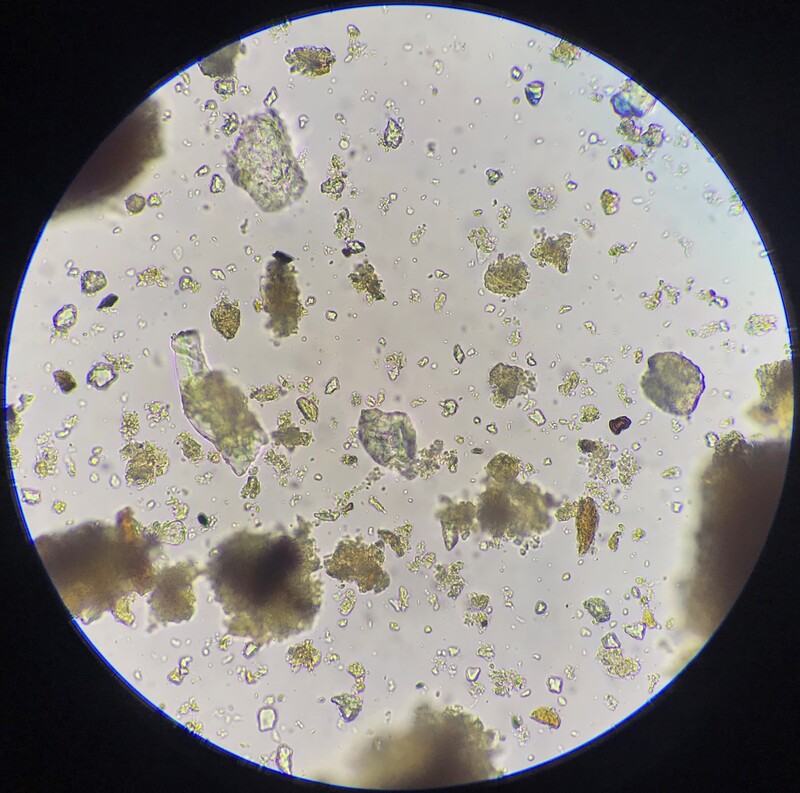
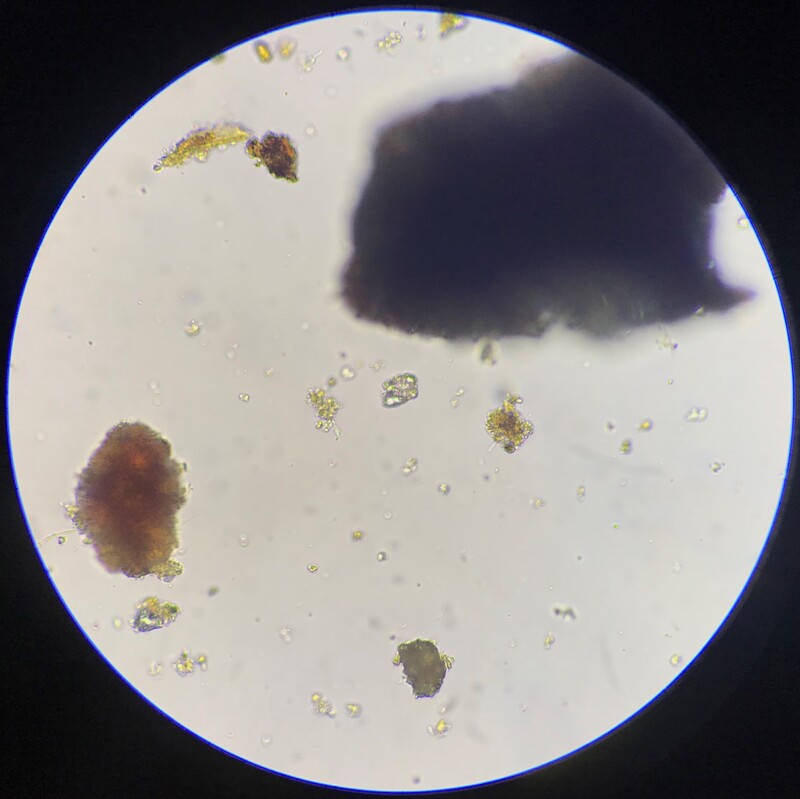
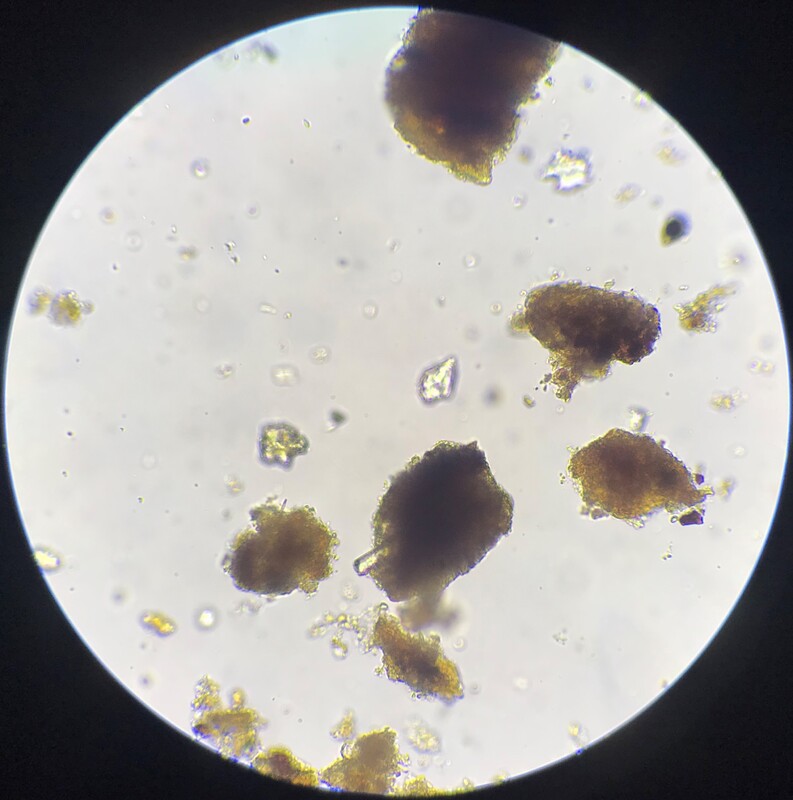
Yields
Charles provided a nice infographic displaying the total yields for the trial beds during the study period along with the inputs and (Figure 8). Both beds were the same size, planted with the same crops, and fed with the same amount of the same compost. The only difference was that in one bed the soil was dug each year and compost was added in trenches and in the other bed the soil was left undisturbed with compost added on top. Over the 7 year trial period, the dug bed produced 656.37 kg of vegetables, and the no dig bed produced 728.46 kg.
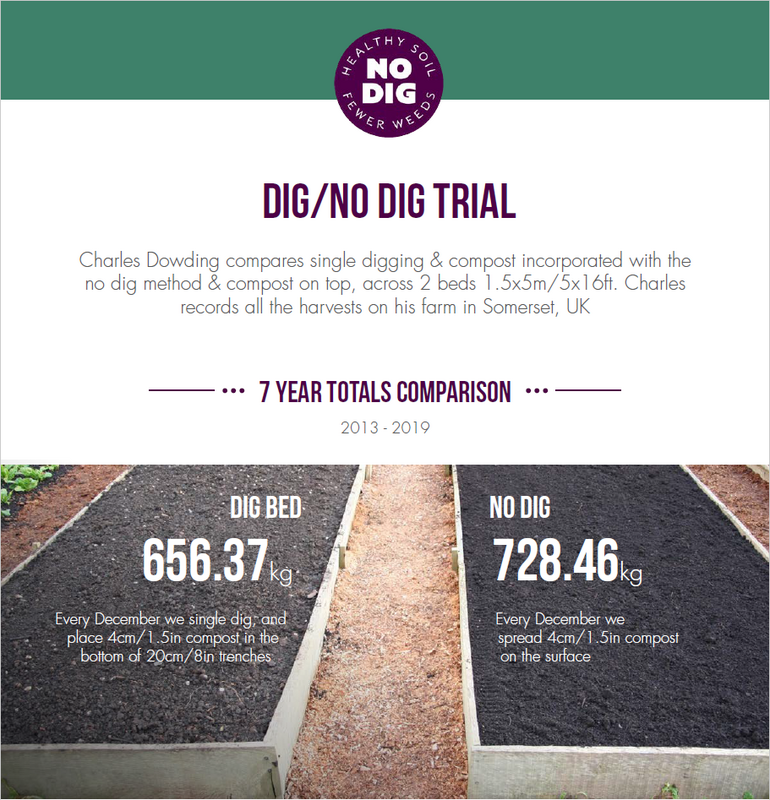
The graph below presents the yields year by year. Notice how the results were quite similar in the first two years, but beginning in year three the difference between them begins to grow, with no dig bed consistently providing greater yields than the dug bed.
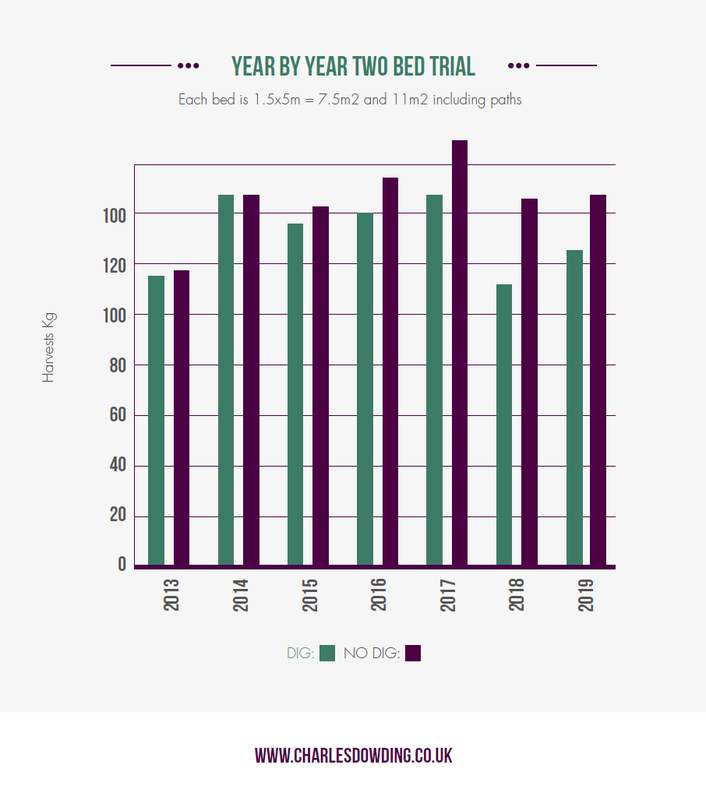
Charles had a statistical analysis performed on the yield results, and the conclusion was that the results were not “statistically significant”, due to some challenges like the small plot sizes and some of the usual challenges with variables in field trials. However, even if the yields were similar, they were definitely not worse, which essentially means that digging accomplished nothing aside from creating extra labour and damaging the soil ecosystem.
Conclusions
It is best to minimize disturbance to the soil. Increased biodiversity at all levels comes with many significant benefits to soil and plant health, nutrient cycling, and more. The soil ecosystem was richer and more complex in the no dig beds, and crop yields improved as well. It is well established that disturbing the soil tears apart fungal networks and damages the physical structure and habitat of the soil ecosystem. The disruption makes it more difficult for beneficial organisms to survive, and creates a more hostile environment for plant roots as well. Disturbed soil has weaker aggregation, which makes it more vulnerable to erosion, compaction, and other environmental stressors, as well as reducing its ability to store carbon from the atmosphere, and even releasing stored carbon back into the atmosphere.
Considering that digging is also more physically strenuous and time consuming for the gardener, it is clear that the no dig approach is better than conventional soil management from this perspective as well. If you find the work of digging to be satisfying and enjoyable, you can easily redirect that energy towards making good compost to spread on top of your garden beds. Or go ahead and do your own side by side trial and compare the differences over time.
When it comes to farming it is even more important (but also more challenging) to make this shift, since so much agricultural equipment is specifically designed to work with soil that has been thoroughly prepared and, unfortunately, damaged as a result. Conventional agricultural techniques are based on outdated ideas about how soil works, but things are changing. There are a lot of creative, pioneering minds out there working towards scaled-up solutions to this challenge, but it can be difficult for farmers to have the flexibility to obtain or experiment with strange new equipment and techniques, let alone entirely new ways of thinking that undermine everything they were taught. It’s a huge shift, and it’s understandable that this will take time to achieve. However, soil degradation is a serious threat to global food security and it is a direct result of conventional agricultural methods. I have seen countless samples over the years that have demonstrated the benefits of organic, reduced or no till operations to the soil ecosystem. We need everyone involved in soil management to be learning, openly sharing knowledge, and working towards solving these problems so we can develop truly sustainable agriculture for the future.


